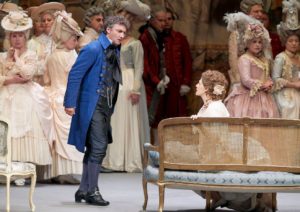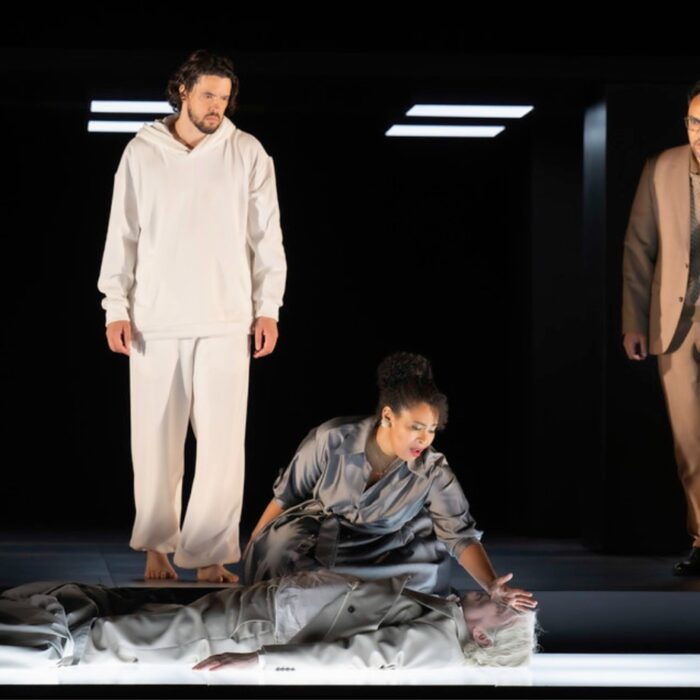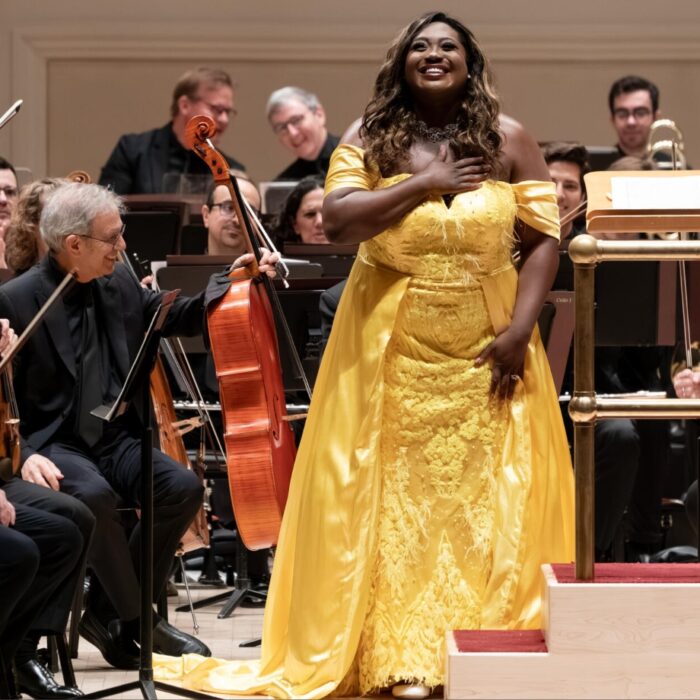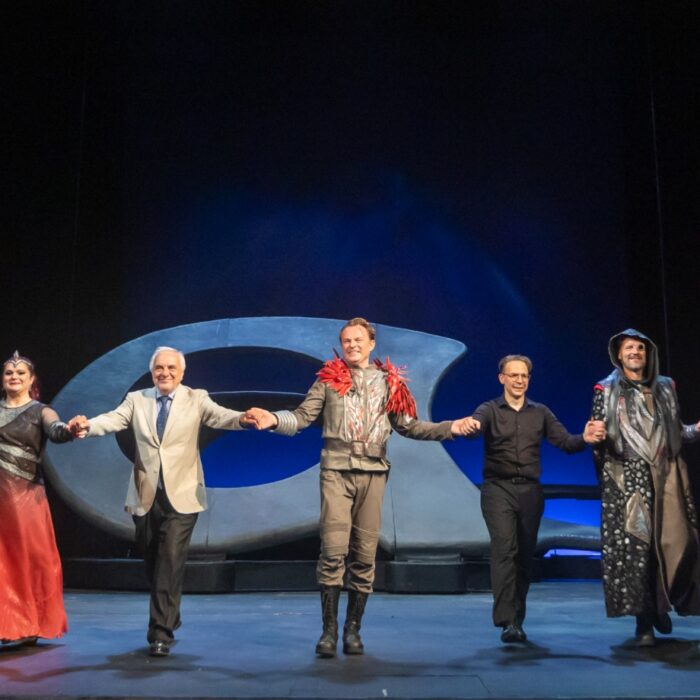
Vienna State Opera 2017-18 Review – Andrea Chénier: Jonas Kaufmann Shines, But Another Star Is Brighter
By Jonathan SutherlandGiordano’s “Andrea Chénier” is in many ways a sibling of Puccini’s “Tosca.” Both were sired by librettist Luigi Illica and both share the staple verismo ingredients of sex, politics, romantic obsession, frustrated baritones, and a grim end for the protagonists. There is also the common factor of youth in all its sanguine exuberance. Cavaradossi and Chénier are idealists with fatal subversive proclivities, while Tosca and Maddalena are plucky paramours prepared to follow their beloveds into oblivion. Sardou’s Tosca was in her 20’s when whisked from the convent by Cimarosa and the romantic French poet was 31 when he met Madame la Guillotine. In fact, Giordano’s original Chénier, Giuseppe Borgatti (who was formerly an illiterate bricklayer from Ferrara) was only 25 when the opera premièred at La Scala in 1896. Interestingly, Jonas Kaufmann was 46 when he first sang Chénier at Covent Garden.
Whilst callow tenors like Borgatti, Pertile or Caruso may no longer be so ubiquitous, many productions, especially in Vienna, have the gift of eternal life. Boleslaw Barlog’s “Salome” for example seems to have been around since Herod Antipas. Otto Schenk’s extant Staatsoper production of “Andrea Chénier” dates back to 1981 when it was staged for Plácido Domingo, Gabriela Beňačková, and Piero Cappuccilli.
Old Remnants
Like the ancient régime and most of la Comtesse di Coigny’s guests, Rolf Glittenberg’s mis-en-scène was starting to look a little frayed around the edges. The décor of Château Coigny relied on large drapes and trompe l’oeil theatre loges for the soirée musicale, which bore little resemblance to Illica’s salubrious winter garden. Milena Canonero’s costumes were almost entirely in clotted cream with Chénier an obvious outsider in an ironically royal blue frock coat. The impudent peasants who crash the Countess’s festivities were extraordinarily well-behaved, more like low-budget tourists who have dutifully bought tickets to inspect the Château and gawk at its aristocratic occupants. The remaining three acts were in the courtyard of a large residential block with nothing to indicate the Hottot tavern, Terrasse des Feuillants, Revolutionary Tribunal or Prison de St. Lazare.
The tricoleur-draped statue of Marat was the skin-diseased tyrant post “bisou de Charlotte Corday,” with his head drooped at a less than heroic angle similar to Jacques-Louis David’s portrait. In any case, there was only a shrine-less sculpture, so Maddalena’s “Ecco l’altare” didn’t make much sense. There was always a degree of chaos in the proceedings of the Tribunal criminel extraordinaire but at least they were held in a building and not the al fresco kangaroo court in Schenk’s production. There was no passing tumbrel at which the vindictive rabble could hurl rotten fruit and vegetables. The only time the ominous chariot appeared was at “Nell’ora che si muore” when Chénier and Maddalena hopped onto it as if out for a quick spin around the Bois du Boulogne.
Mixed Bag of Comprimarios
Apart from the three principal roles, “Andrea Chénier” requires twelve comprimario parts which are usually well supplied by most ensemble companies. It was surprising that the Wiener Staatsoper casting was noticeably so variable. As Countess di Coigny’s pompous major-domo, Marcus Pelz lacked presence and projection and Manuel Walser’s serious schmoozer Pietro Fléville wasn’t much better. The alpha sans-culotte Mathieu was sung by Wolfgang Bankl but was small in voice and bland in characterization and it was no surprise his fund-raising efforts were a failure. Even “La Marseillaise” was fainéant. As the loathsome and historically accurate Fouquier-Tinville, Alexandru Moisiuc displayed commendable gravitas with solid intonation and his short declamations such as “Mie faccio queste accuse e le rinnovo!” had a menacing Scarpia-ish edge. Donna Ellen was a suitably snobbish Countess with a haughty “après moi le deluge” approach to “L’interrotta gavotta, mie dame, ripigliamo!” As the fanatical old revolutionary granny, Ukrainian mezzo Zoryana Kushpler displayed not only a strong mid-range and excellent projection but accomplished acting skills. “Son la vecchia Madelon” was a fleeting highlight in the ragbag rumpus of Act three, although her surrendered grandson looked about 10.
As Fernando Radó showed in David McVicar’s recent “Chénier” in Barcelona, the role of the doomed poet’s faithful friend Roucher can be surprisingly rewarding. Boaz Daniel was not nearly as convincing and there was only minimal impact in his short “La tua divina soave poesia” scena with Chénier. Carlos Asuna looked far too innocent to be the vicious voyeur spy Incroyable and his voice was too crooning for the ideal astringent characterization. “No, non m’inganno!” needed much more nastiness and far better diction. Tatarstan born mezzo Ilseyar Khayrullova sang a technically correct Bersi but without much conviction. This is the servant/companion of a suddenly impoverished and outlawed aristocrat who not only acts as a courier between Maddalena and Chénier but turns to prostitution to support both herself and her ex-boss. A rather onerous job description at any time. “Vivere in fretta” had all the notes but lacked nuance and the final F sharp on “passa” was less than pristine.
Ensemble sections were generally much more consistent and the slow triple time “O Pastorelle, addio” chorus of soi-disant shepherds and shepherdesses was blithely delicate and correctly observed the grazioso pianissimo markings. The more boisterous ensemble passages such as “Morte ai Girondini” had dynamism and punch. The excitement of the hoi polloi seeing their revolutionary heroes “Barère! Collot d’Herbois! Couthon! Saint-Just!” et. al. was convincing, but Robespierre must have been even smaller than Chenier jibed, as like most of the other notables, he was invisible.
The Servant Turns Revolutionary
Roberto Frontali was a thoroughly credible former servant turned disillusioned revolutionary. He was also the only singer with consistently impeccable diction. This Gérard may not have had the hard edge gutsiness of Luca Salsi in Munich or the overpowering Cappuccilli-esque authority, but it was still a commendable effort. “T’odio, casa dorata!” could have had more venom and the high F sharp on “È l’ora della morte!” was a bit pushed, but “Lacrime e sangue dà la Francia!” displayed a fine legato with honeyed timbre. The heroic “Nemico della patria” aria displayed a mellifluous middle voice with some outstanding marcato fortissimo D sharps on “traditore” and top E naturals on “e mentre uccido.” The intensely lyrical “La coscienza nei cuor” passage was reminiscent of Renato Bruson in its warm phrasing although the sustained F sharp on “un sol bacio” was slightly pinched.
Suprisingly Less Than Stellar
Anja Harteros has become Jonas Kaufmann’s companion of choice to the guillotine and there was much to admire in her interpretation of the ill-fated aristocrat. The main problem is that Harteros never seems more than dramatically monochrome, if not blancmange. There was no character development at all between the enfante gâtée in the first act and the resolute woman who volunteers to die with her beloved in “La nostra morte.” There were several instances of singing fractionally below the note although the top B flat on “Amante” leading to the final duet was laser accurate. There was a luscious vibrato-less pianissimo F natural on “Proteggermi volete?” followed by a splendid fermata on “spero in voi” but the anguished Tosca-ish C sharp chest notes on “prendimi” needed much more meat. “La mamma morta” seemed more like a circumspect concert aria than an impassioned account of horrendous events which included the murder of her mother and pillaging of the Château. The top B natural fermata on “un ciel” was a loggionisti pleaser but fell short of true spinto.
Star Tenor Makes His Mark
The big attraction of this production was unquestionably Jonas Kaufmann singing his first Chénier in Vienna. Covent Garden audiences were privileged to hear him three years ago in David McVicar’s lavish production but in the interim the star tenor reportedly had to take several months off to deal with a burst blood vessel in the throat. Obviously any problem with the vocal chords is especially alarming for a singer, and post-recovery caution is not only understandable but essential. Kaufmann’s unique smoky, burnished baritonal timber was certainly still evident and there were some absolutely bravura upper register notes such as the B flats on “Credi al l’amor” and “Ah, mio bel sogno.” There was more fire and fine phrasing in “bella, ideale, divina come la poesia,” but similar to his performance in Barcelona earlier this year, the crescendo A flat on “Ora soave” was tentative, sfogato, and below pitch. It is actually marked diminuendo in the score. Kaufmann seemed more confident with the upper register in the duets and there were some dynamite B flats in unison with Harteros such as the sustained fortissimo “Insiem’ in the Act two duo and the “Amante!/È il mondo!” fermata leading into the rapturous “La nostra morte.” The final heroic optional B natural fermata “Amor” was verismo par excellence.
The star tenor’s overall performance, however, was much more timorous than temerarious, which was certainly not the case at Covent Garden in 2015. The “Improvviso” was almost off-hand with a shortened G natural on “firmamento” and truncated fermata on the top B flat at “T’amo tu che mi baci.” Despite the orgasmic string accompaniment, “Eccola la bellezza della vita” lacked raw potency and “Amor, divino dono” was rushed and not particularly ardent. Other than the semi-subversive text, there was little reason for the Countess to swoon in shock or the Abbé to choke on his plate of marmalade.
By the last Act, Kaufmann was more relaxed and “Come un bel dì di maggio” displayed his customary finessed phrasing and seductive timbre. Despite the noticeable dramatic disengagement and early vocal equivocation, the adoring Viennese audience was much more convinced than Fouquier-Tenville or Dumas.
The True Star
Marco Armiliato wasn’t going to let star singer hubris hold back the orchestral forces of the Staatsoper musicians and there were Wagnerian blasts from the pit. Trombones provided lots of oomph in the raucous con fuoco instrumental passage after Bersi’s scena and the ominous fortissimo chords opening Act three, but there were also moments of extreme sensitivity such as the solo violin in “Scrive una donna misteriosa” and the cello obbligato during “Son la vecchia Madelon” and immediately after Maddalena’s “Prendimi.” The famed Vienna strings leapt into a scintillating start with pristine semiquaver runs presaging the party to come. They also excelled in later lyrical passages with ravishing soaring scales during Gérard’s “Dammi codesta creatura vaga!” Giordano’s original percussion effects with tamtam, sleigh-bells and tamburi added color to the orchestral palette.
Armiliato’s tempi were brisk in the ensembles, but remarkably slow in many of the arias, especially in the scoring for Chénier. The “Improvviso” is marked “andante” not “lento” and “Come un bel dì di maggio” indicated as “andantino” and not “pesante.” Ending literally on a high note, there was a roof-raising orchestral climax to “La nostra morte è il trionfo dell’amor!”
This performance may have been a triumph of the love held by many in the auditorium for the two principal protagonists, but the most verismatic ardour came from Marco Armiliato in the pit.


